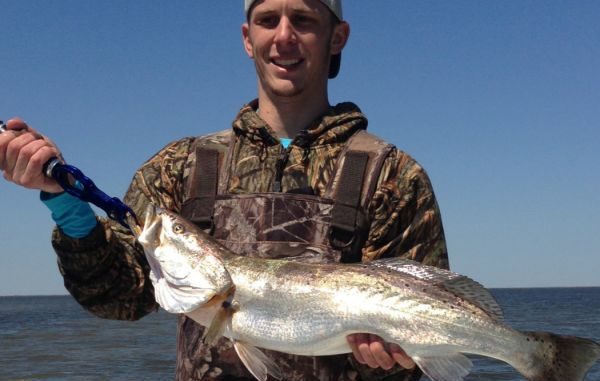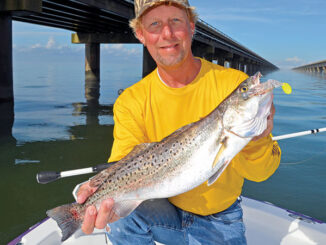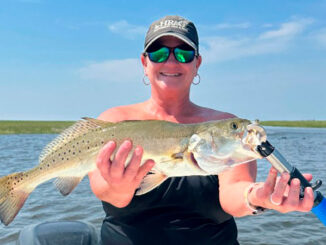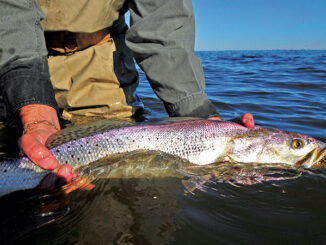
Tactic allows areas to be fished thoroughly, prevents spooking specks, fishing guide says.
A lot of things can be said about Texans. Many of of them are far from fit for a family publication. But never let it be said that wading for trophy speckled trout is among the negatives. Capt. Jared Allen of Adams Trophy Charters is a convert. A lifelong angler of Lake Calcasieu (or Big Lake as it’s known to almost everybody), Adams used to scoff at the growing legions of Texas anglers purposefully jumping out of perfectly good boats.
Two years of catching scads of specks approaching 10 pounds in cool, waist-deep water brought him over to the Lone Star State’s way of thinking.
“It’s not as easy as finding a nice shoreline and jumping in,” said Adams, who fishes out of Spicer-Hughes Marina in Hackberry on Big Lake’s west side. “The best areas we’ve been fishing are ones we’ve found fishing out of a boat.
“The thing about wading is that it allows you to really work over a good area. You’re not going to drift over those fish, and you’re not going to spook those fish with a boat.”
Joining Adams for a morning of trophy hunting was Stephen F. Austin University pole vaulters Cameron Meyer of Lake Charles and Colton Ross of Grand Prairie, Texas. The duo had a meet at ULL coinciding with Spring Break, and somehow finagled a trip in between practices.
The first hour was spent chunking MirrOdines, a small, darting MirrOlure jerk bait, on a reef on the lake’s east side. They boxed 20 small keepers in the morning calm before moving on to their big business: big baits, big water and big-boy attitude needed to give oneself a chance at a trophy trout.
“There are some days when you can get on a school of big fish and catch 20 or so,” Adams said, “but a lot of times you’re looking for one big bite.
“It takes a lot of casts and a lot of patience to stick with it.”
This day proved to somewhere in the middle. Several spots produced nothing before we came upon a wind-blown, waist-deep stretch of patchy mud-and-shell bottom.
“This is a spot where if we can get five bites I’m pretty sure one of them will be over 7 pounds,” said Adams as he glided away from the boat, anglers in tow and the clock ticking.
An hour and a half later, the fruits of such hope were being replayed as Ross, whose biggest trout previously was “around 3 pounds,” posed patiently for pictures with a 29 ¼-inch beauty that was bound for the taxidermist.
The tally from that spot: four confirmed bites that included a 5-pounder released and a 22- and a 23-inch fish put on the stringer, plus Ross’ big one.
The 23-inch fish followed what Adams said was a bigger fish lost on the same cast. So let’s say four bites and change.
Something Ross, I’m sure, would take over again.


